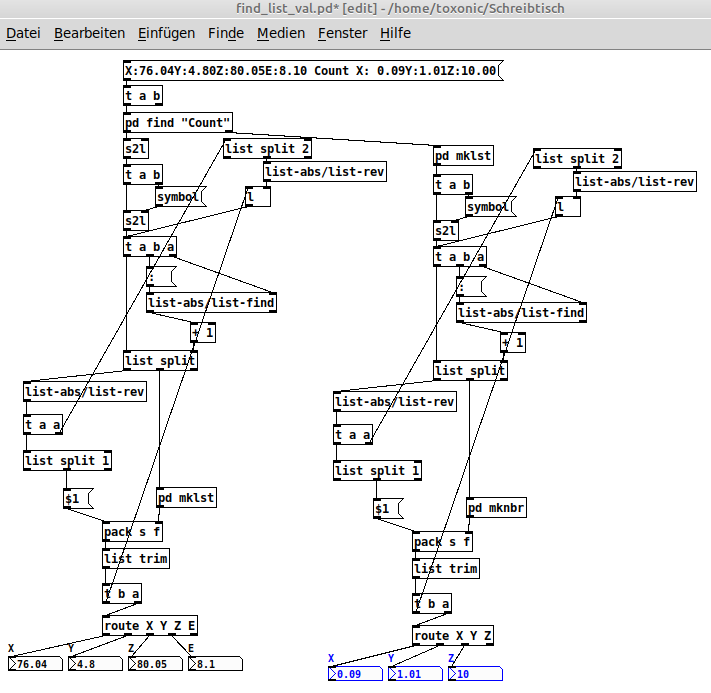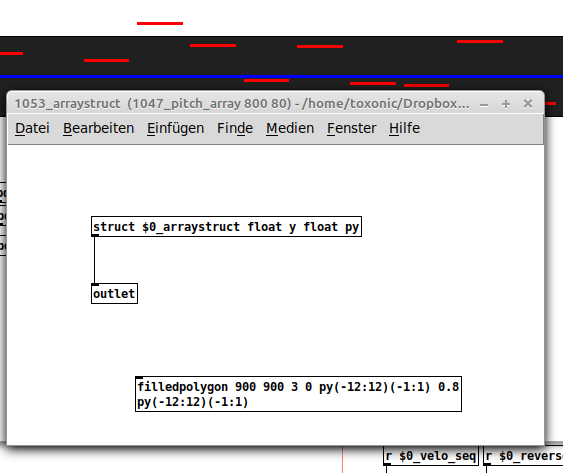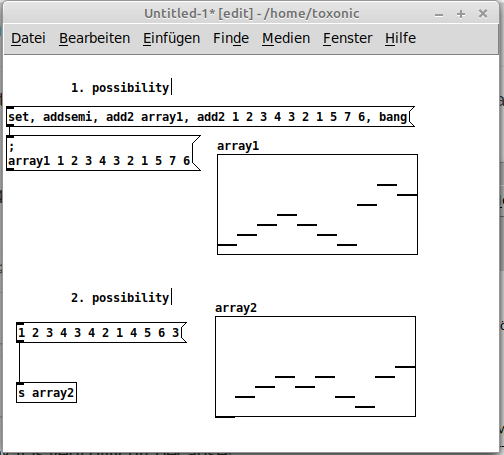-
toxonic
posted in technical issues • read moreI think, it's far from perfect, but i tried to build something similar some years ago. However, maybe it's a starting point....
 quadropan.pd
quadropan.pd -
toxonic
posted in patch~ • read moreSince i recently updated my linux mint 19.3 tricia distro on my pc, this patch crashes pd immediately on startup with error message "Signal 4" (tried with pd 0.50.0 and 0.51.4). On my notebook with the same distro but not updated for a while, it still works fine with pd 0.50.0.
Any ideas on the error message "Signal 4"? -
toxonic
posted in technical issues • read more@whale-av thanks david, that should work.
 the downside though is, that, if you put this patch inside an abstraction or a subpatch, which itself is in GOP mode, you need to put the paint subpatch into the gop area too, because otherwise the data won't be displayed. but that's not such a big deal in my case, since you can adjust the GOP x and y values and size of the paint subpatch, so that it's just a slim stripe right under the displayed array.
the downside though is, that, if you put this patch inside an abstraction or a subpatch, which itself is in GOP mode, you need to put the paint subpatch into the gop area too, because otherwise the data won't be displayed. but that's not such a big deal in my case, since you can adjust the GOP x and y values and size of the paint subpatch, so that it's just a slim stripe right under the displayed array. 
-
toxonic
posted in technical issues • read moremhh, strange - dosn't work for me as array element....
array_test_-x-flag.pdedit: as a workaround, i could declare "float y" in the array template and use the "-y" flag (with some imaginary variable assigned) in the [plot] object, but you would still see the arrows when hovering over the array elements....
-
toxonic
posted in technical issues • read moreis there a way to surpress mouse actions in data structure arrays? i am afraid, the answer is no, but i thought, maybe one of the DS wizards here in the forum knows a way to achieve this.
just to clarify, i want to use a square (filledpolygon) as array-element to build a background for each cell of a step-sequencer. since it should only be a design element, it should not get any mouse events. adding the -x flag to the filledpolygon doesn't do the trick and [plot] doesn't accept that flag (respectivley, it has another function there).
thanks in advance!

-
toxonic
posted in technical issues • read more@Pimp_me
just, because couldn't let it be...

and here the patch: find_list_val.pd -
toxonic
posted in technical issues • read more@Pimp_me i'm pretty sure, that someone already built an abstraction, that solves such tasks in an elegant way - however, i don#t exactly know!
 i just tinkered around by trial and error and i have to confess, i feel a bit ashamed about such an akward patch. but maybe it could be a starting point. i'm sure, this can be refined or build another way. at the moment, it only works, as long the integrals a below than 10.
i just tinkered around by trial and error and i have to confess, i feel a bit ashamed about such an akward patch. but maybe it could be a starting point. i'm sure, this can be refined or build another way. at the moment, it only works, as long the integrals a below than 10. 
find_list_val.pd
basically, i convert the symbol into a list, break it up into it's single elements and look for the indicies of the colons. then i route these indicies to [list split] units, wich extract the first element after each colon. -
toxonic
posted in technical issues • read more@ingox @Jona @whale-av @Balwyn People, you are really amazing!
 All these hints are very useful! in this particular case, @ingox / @whale-av 's tip regarding [receive pd] is a solution, which works pretty well and makes [mousestate] unnecessary! however, a big thanks to each of you!
All these hints are very useful! in this particular case, @ingox / @whale-av 's tip regarding [receive pd] is a solution, which works pretty well and makes [mousestate] unnecessary! however, a big thanks to each of you! 
-
toxonic
posted in technical issues • read more@whale-av hey, that's quite nice!
 i got an error message, although it seems to work though.
i got an error message, although it seems to work though.UNHANDLED ERROR: extra characters after close-quote while executing "pdtk_post "loaded: experimental mouse plugin "`" ("uplevel" body line 17) invoked from within "uplevel #0 $tclcode" FAILED TO LOAD /home/toxonic/.local/lib/pd/extra/focused_mouse-plugin.tcl -----------EDIT: found the buck, there were some " ``` " signs at the end of the code.
after restarting pd (not the patch) it spits out a lot of error messages,: mouse recieve: no such object..
anyway, thanks for the idea!
-
toxonic
posted in technical issues • read more@ingox yeah, but that's what i've been looking for - i didn't think of using plot for limiting the values.
 in this case, i don't need the index of the modified array element, because the values will triggered by a sequencer, that just iterates through the array. i store all the values at once with a combo of [array get] / [array set].
in this case, i don't need the index of the modified array element, because the values will triggered by a sequencer, that just iterates through the array. i store all the values at once with a combo of [array get] / [array set].
what i still find unsatisfying is, that i don't get it to work, that the values get stored in a hidden table, that saves the contents with the patch, right after i changed a value. at the moment, i use [mousestate], wich let's me store the values, just when i release the mousebutton. i'd love to get this in vanilla, but it seems that the data structures only give me click events, but not when the mousebutton is released. but ok, thats off topic now.... if someone knows a good workaround though, don't hesitate to reply!
if someone knows a good workaround though, don't hesitate to reply!  however, thank you very much!
however, thank you very much! 
-
toxonic
posted in technical issues • read more@Boran-Robert thanks, but unfortunately it doesn't!
 i already checked that, there's not much about arrays... indeed this was the first document i read regarding DS, because it's also pubished in my native language (german). anyway, thanks for your reply.
i already checked that, there's not much about arrays... indeed this was the first document i read regarding DS, because it's also pubished in my native language (german). anyway, thanks for your reply. -
toxonic
posted in technical issues • read moreand once more a question on data structures...

how can i limit the range of a field in an array? this here doesn't seem to work:

-
toxonic
posted in technical issues • read morethis one using [expr] should do, what you want.
xyz_true.pd -
-
toxonic
posted in technical issues • read morenot sure, if i really got you, but here are two different ways, to set values in an array.
the first on creates a message and finally bangs it.
the second one uses send. you could setup the message according to the first way too.

-
-
toxonic
posted in patch~ • read more@Boran-Robert
amazing patch and a lot of fun to play with! i had a quick look inside and discovered, that you put in a lot of arrays, holding different scales - just a small suggestion: for the diatonic stuff (ionian, lydian,....), you only need one scale, which you shift through by a certain amount of steps, so you can represent all the diatonic scales. sorry for my poor english, this patch might be easier to understand.
i had a quick look inside and discovered, that you put in a lot of arrays, holding different scales - just a small suggestion: for the diatonic stuff (ionian, lydian,....), you only need one scale, which you shift through by a certain amount of steps, so you can represent all the diatonic scales. sorry for my poor english, this patch might be easier to understand.
diatonic_2.pd -
toxonic
posted in patch~ • read moredon't really know anything about ratts, but it seems, that there's a precompiled binary for windows though (but i guess this is a 32 bit binary):
https://kaskade.dwds.de/~moocow/mirror/projects/pd/ratts-2008-06-30.mingw32_nt-5.1_windowsxp-i386_pd-extended.zip
don't know, if this helps you... -
toxonic
posted in technical issues • read more@whale-av
nice! by the way, couldn't you just leave out the [list prepend symbol] and [list trim]?
by the way, couldn't you just leave out the [list prepend symbol] and [list trim]?

works for me without these...
